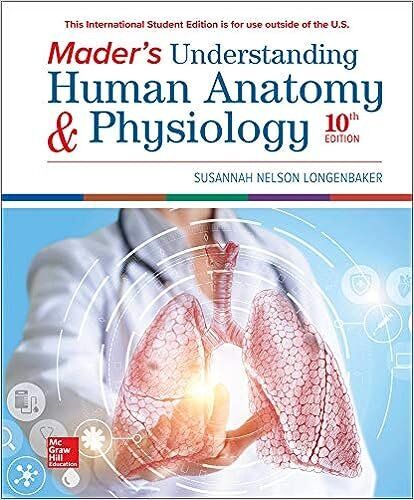Test Bank For Maders Understanding Human Anatomy And Physiology 10th Edition Longenbaker
Chapter 3 Cell Structure and Function
1) Which of the following types of cells are anucleate when mature?
A) Liver cells
B) White blood cells
C) Erythrocytes
D) Skeletal muscle cells
2) Which are found inside the nucleus? Choose all that apply.
A) Rough endoplasmic reticulum
B) Lysosomes
C) Chromatin
D) Nucleolus
3) The gelatinous supporting material of a cell is the
A) plasma membrane.
B) nucleus.
C) cytoplasm.
D) organelle.
4) Small structures that compartmentalize the cell for the various cellular activities are
A) nuclei.
B) organelles.
C) matrices.
D) mosaics.
NURSINGTB.COM
5) The plasma membrane consists primarily of
A) phospholipids and proteins.
B) sugars and starches.
C) phospholipids and nitrogenous bases.
D) sugars and proteins.
6) Which are characteristics of the cytoskeleton? Choose all that apply.
A) It is made up of filaments and microtubules.
B) It produces proteins.
C) It stores calcium.
D) It maintains cell shape.
7) The phospholipid molecules are arranged with
A) the hydrophilic tails facing outward and the hydrophobic heads facing inward.
B) the hydrophilic tails facing inward and the hydrophobic heads facing outward.
C) the hydrophilic heads facing outward and the hydrophobic tails facing inward.
D) the hydrophilic heads facing inward and the hydrophobic tails facing outward.
8) Think about the bilayer arrangement of phospholipids in cell membranes. Now imagine if
extracellular and intracellular fluids were made of oil instead of water. How would the
phospholipids arrange themselves?
A) The hydrophilic heads would be oriented toward the middle, with hydrophobic tails pointing
outward.
B) The hydrophobic heads would be oriented toward the oil, so outward; the hydrophilic tails
would be pointed inward.
C) The hydrophobic tails would be oriented inward, while the hydrophilic heads would point
outward.
9) The movement of protein molecules within the phospholipid bilayer is described by the
A) fluid mosaic model.
B) lipid mosaic model.
C) protein-lipid mosaic model.
D) cholesterol mosaic model.
10) The presence of cholesterol molecules in plasma membranes is to
A) allow the buildup of fats.
B) change the chemical nature of the membrane.
C) create a mosaic pattern.
D) stabilize the phospholipids bilayer.

Reviews
There are no reviews yet.